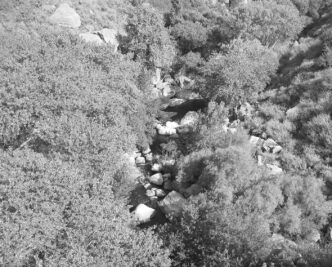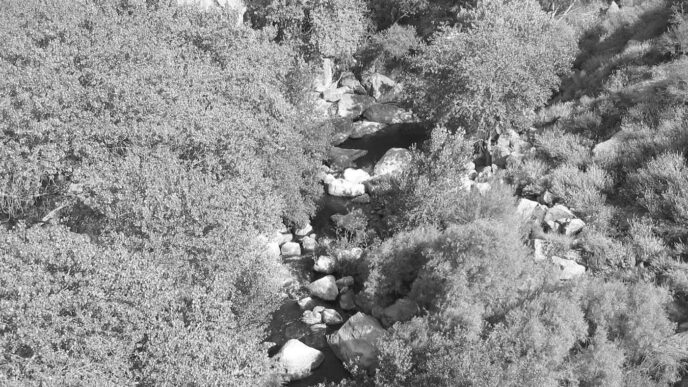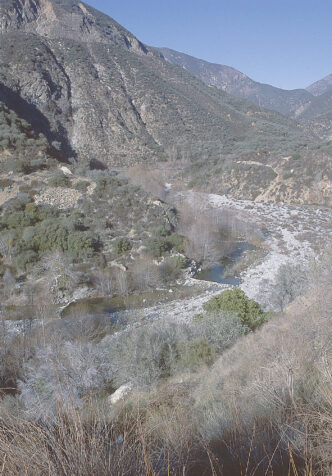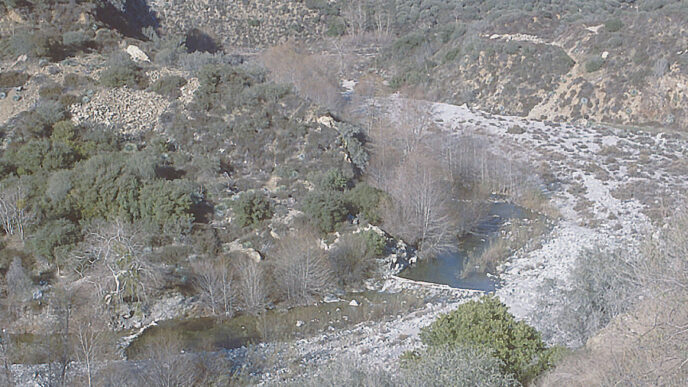I have always enjoyed wild game of all types in a meal, whether it is a Thanksgiving dinner of wild turkey cooked outside on my Big Green Egg or a special repast in camp on the shore of a favorite lake or stream. I follow Claudia Roden’s mantra, “Everything tastes better outdoors.” Since I now hunt mostly with a fly rod, the availability of such wild delicacies has dropped dramatically. Fortunately, the taste and health benefits of game are such that specialty markets and butchers now stock or can order a variety of farm-raised animal meats.
My wife and I are both meat lovers. The low-fat health benefits of farm-raised game have allowed us to have meaty, tasty meals at home and while camping and still comply with a plan for lowering calories, fat, and cholesterol. We have come to enjoy bison, also known as buffalo, in groundmeat form and as a tri-tip or New York–cut steak. We use ground bison for a bolognaise or spaghetti sauce and tasty bison burgers. Elk is a bit harder to obtain, but it is every bit as good, possibly better. Bonein chops are a favorite. Venison tenderloin can take the place of a Christmas prime rib, and an elk/wild boar chili with a tomatillo–white chocolate sauce is to die for.
Jeremiah Johnson as played by Robert Redford was accepted into the “mountain man” culture of the Rocky Mountains because of his fighting and survival skills and because he cooked a mean rabbit on a spit. Rabbit, easily obtained in Europe and Canada, has become increasingly available in markets here in the United States, as has farm-raised quail, duck, and pheasant. Marinated and grilled on a medium flame, rabbit is succulent, and its flavor is intense. On a wild-game calorie, fat, and cholesterol chart, it is the lowest per gram, beaten only by squirrel meat. I make a beef broth-based three-mushroom light rabbit stew with a vegetable reduction that is served on grilled polenta or artisan bread, and it travels well. You can do the entire cooking process at home and then warm the dish in camp for a quick, hearty first night meal or do the reduction first and finish the dish in camp by browning the rabbit pieces and simmering them in the thawed reduction. Artisan bread that is rubbed with raw garlic, drizzled with a good olive oil and toasted on an outdoor grill can take the place of a more time-consuming polenta. A few sprigs of fresh sage complement and intensify the flavors.
I like high-quality food in camp, but ease of preparation and simplicity gives me more time to enjoy the campfire and even hit the sack early if I want to catch the bite at dawn. Often, my friends and I return from fishing late and need meals than can be put together quickly. Bison burgers fit the bill perfectly. I do Burger and Zinfandel Night at Jack Rabbit Hill for the Sierra Grape Growers and Vintners once a year and more often for my wife and me. The bun is as important as the meat. You need one that won’t fall part with a perfectly cooked medium-rare burger that drips juices and already has some damp condiments. Save Mart (the old Albertson’s and before that Lucky), has a bulk bun that is baked daily and sells three for a dollar out of a clear plastic bin in the deli/bakery department. They will make you a hundred or more on a day’s notice for a group event. That bun also travels well.
Raise the bar further on your bison burgers with a special cheese and some caramelized onions. We mix gorgonzola crumbs with mayonnaise or use an easy melting Fontina or white Wisconsin farm cheddar. It is worth seeking out a good wine to complement that bison burger. Neighbor Gus Young won the gold again this year with a Zinfandel/Syrah blend that originated in the old Polaris vineyard down the road in 2007. Their ranch pond produced a 10-pound bass on a big Woolly Bugger — more reason to celebrate with a good meal.
A meal in camp with game adds to the outdoor aura and enjoyment. If there are kids or grandkids in your group, bison burgers, bison hot dogs, or better yet, bison tri-tips, along with some Wild West tales, will never be forgotten, particularly if there are sharpened green sticks and marshmallows and maybe some stories about Kit Carson, Jedediah Smith, and Jim Beckwourth thrown in. All of us are far removed from claiming “When I was young and on the plains, we grilled buffalo tongue on a green stick.” It has no credibility, because kids today are smart, but tales of mountain men and lessons in Western history are well received around the campfire. Besides, they won’t believe the “snipe hunt” stuff anymore, either.
My late friend and fishing partner Jon Stromer would always come in early one day on an extended trip and spit grill a turkey on the coals with a jury-rigged aluminum reflector. His kids didn’t know that it wasn’t a wild turkey and talked all year about the summer outing. With potatoes and onions, the leftovers made a great breakfast hash. Where I live, wild turkeys are tolerated as a nice pest, but a few who intrude in the flower garden or vineyard get breasted and hot smoked every year.
Because wild or farm-raised game is not marbled with fat like a feed-lot steer, a cardinal rule in preparing meat such as bison is to serve it medium rare and cook it at lower temperatures. Too hot a fire and overcooking it only make it tough and dry. Some cooks drape bacon or pancetta over a piece of meat to keep it from drying out, but that drives up the fat content. It isn’t necessary. Kill the center burners on a gas grill and cook with indirect heat under the hood. It is a good idea to carry small instant-read digital meat thermometer. Pull tri-tip at 130 to 135 degrees Fahrenheit and cover it with foil. The meat will “rest,” and the juices will pull back into the tissue. The internal temperature will rise another 10 or so degrees in that time. Curiously, bison does not shrink when cooked. In fact, it may puff up a bit. After the meat rests, slice it as thin as possible cross grain, as when grilling a flank steak. Watch your first try cooking game and don’t overcook.
Rabbit, pheasant, prairie hen, and chuckar shouldn’t be served pink for obvious food-safety reasons, but watch them carefully and don’t overcook the succulent meat. At home, I marinate game, most often in a commercial vinegar/herb product called Basque Meat Tenderizer. My attempts to duplicate it using vinegar from my vinegar mother, garlic, and herbs don’t get the same results. Vinegar-based marinades tend to be antibacterial, but that doesn’t mean you can ignore food-safety issues. A cut of meat in a well-sealed double Ziploc bag with some marinade travels well. Tri-tips hold up to 24 hours. Pack the meat in your camp cooler, and it is ready to go by dinnertime. Pat it dry and season it with a spice rub, but just enough to complement the meat. Don’t overseason, which can overpower the flavor of your expensive cut. McCormick’s Grill Mates Montreal Steak Seasoning takes the place of four or five different rubs in my simplified camp kit.
I remember a memorable meal on the banks of the Little Truckee River the night before land use regulations prohibited vehicle access to the west of the road between Boca and Stampede Reservoirs. We camped under a still-erect “lightning tree” and used a waterlogged stick to impale a marinated sirloin mock “bear roast” that was leaned over the coals in the Argentine fashion. We seasoned it with garlic salt and basted with a spray-bottle mix of soy, cheap red wine, and olive oil. Dinner never really arrived, because we carved off each layer of succulent crust with sharp hunting knives as it came done. Side dishes included Yolo Bypass corn, foil wrapped potatoes, and garbage-sack salad dressed with Wishbone salad dressing. Keep it simple in camp.
Today, the sirloin roast could be a buffalo tri-tip, and we would need to have our party in a designated campsite. The Boyington campground is downriver and has nice fire rings. Organic baby arugula dressed with a light Arbequina olive oil and a drizzle of champagne vinegar, with a dusting of sea salt and freshly ground pepper, could round out the greens. I still like that Yolo Bypass corn in foil with lime juice, mayonnaise, and chili powder or Luzianne Cajun Seasoning. A rabbit pâté on artisan bread would make a fine appetizer.
In the 1970s, I occasionally made fishing trips on a lean budget with flyfishing notables-to-be Gary Greenlee, George Durand, and Carl Mottice, and we fancied homemade pies on the road. We sure could mess up a motel room with the flour, butter, sugar, and sticky fruit, but they were awfully good. Today, if you are driving up Highway 80 to visit Tahoe or the Truckee area, be sure to stop at the Foresthill exit outside Auburn. Ikeda’s and competitor Machado’s across the interstate make killer marionberry pies, and they have better fresh produce than the Truckee grocery stores an hour up the road. Add a little vanilla bean ice cream with some freshly ground nutmeg to the top of that pie and a dash of Grand Marnier.
Here’s a recipe for a sauce for buffalo steaks. It has a bit of a kick, thanks to Jack
Daniels and green peppercorns. Give it a try, the next time you’re in camp. You will have raised the bar in camp cooking.
Buffalo Strip Steaks with Jack Daniels Sauce
6 boneless buffalo steaks
Salt and white pepper
1/4 cup minced shallots
1/2 cup sliced mushrooms
4 tablespoons unsalted butter
2 cups low-sodium beef stock
3/4 cup dry white wine
3/4 cup Jack Daniels
2 tablespoons lightly crushed green peppercorns
1/2 cup cream
Fresh lemon juice
Season the steaks with salt and pepper and let stand for one hour at room temperature. Sauté the steaks in butter until medium rare, two to three minutes per side. Do not overcook.
In a sturdy skillet, sauté the shallots and mushrooms in two tablespoons of butter until golden brown. Add the beef stock, wine, 1/2 cup of the Jack Daniels, and one tablespoon of peppercorns and reduce over medium heat by half. Add the cream and reduce to a light sauce consistency. Whisk in two tablespoons butter a bit at a time. Add the rest of the peppercorns and the rest of the Jack Daniels, then add lemon juice to taste. The sauce can be made ahead and kept warm. Zinfandel, primitivo, or petit syrah complement and hold up to the flavors.
Thanks to Chef Lisa Lavegetto at Ramekins Cooking School for the sauce ideas. Stay tuned for the tomatillo–white chocolate sauce.
Cooking Tips for Farm-Raised Game
Here are some suggestions for cooking farm-raised game. If the meat is frozen, let it thaw gradually in the refrigerator, then let it further adjust at room temperature before cooking. You are letting the fibers (fibrous connective tissue, in medical jargon) relax, which promotes tenderness.
So does the “rest period” after cooking, which again relaxes the meat and causes the juices to hold better in your portion when you carve into it. Avoid ever throwing a frozen steak directly on the fire.
Always look for and remove the shiny membranous surface tissue that we call “silverskin” and carve roasts, tri tips, and flank steaks cross grain in thin slices.
Sources for game meats include Whole Foods, which carries freshly ground bison, bison hot dogs, tri-tips and New York strips, and Raley’s, Save Mart, and Safeway, which carry ground bison. You can also order game meat from specialty markets and butchers, as well as from Internet mail-order sources.
Trent Pridemore

















